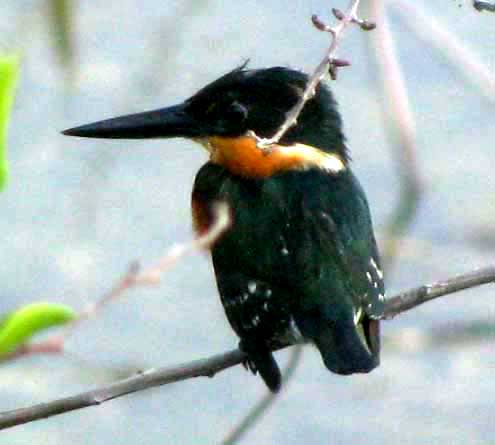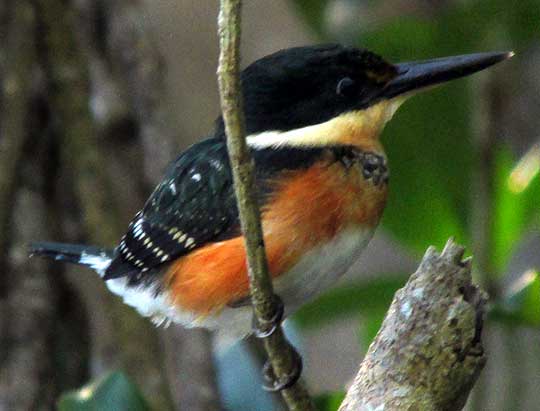Excerpts from Jim Conrad's
Naturalist Newsletter
from the August 28, 2011 Newsletter issued from Mayan Beach Garden Inn 20 kms north of Mahahual; Caribbean coastal beach and mangroves, ~N18.89°, ~W87.64°, Quintana Roo state, MÉXICO
PYGMY KINGFISHER
North America's Belted Kingfisher is about 12 inches long (31cm). On Wednesday morning at a pond fringed with Sawgrass, near the mangroves, a kingfisher about the size of a House Sparrow -- only five inches long (12.5cm) -- alighted on a nearby twig, as shown below:

Throughout the Yucatán two kingfisher species commonly occur, the Green and the Pygmy. This was the Pygmy, CHLOROCERYLE AENEA STICTOPTERA, distributed from southern Mexico to Ecuador and Brazil. The Yucatán's other kingfisher, the Green, also is much smaller than the North's Belted, being only eight inches long (20cm). The Pygmy's throat is rusty colored, though, while the Green's is white, so in the field they're easy to distinguish, even when their relative sizes are hard to judge.
Up North you've probably watched Belted Kingfishers dive for fish, spectacularly splashing into the water. The Pygmy dives with a dainty little kerplunk.
The bird in the picture didn't seem at all bothered to have me ten feet away snapping pictures. In fact, I had to noisily scrape my feet to get her to turn her head for a profile view showing the beak. In this species the female wears a narrow, green chest-band, while the male doesn't. Our bird only watched for prey in the pond water three feet below, but I read that at times Pygmy Kingfishers catch insects flycatcher-like.
from the December 21, 2014 Newsletter issued from Río Lagartos, on the Yucatan Peninsula's northern coast (~N21.60°, ~W88.16°), Yucatán state, MÉXICO
PYGMY KINGFISHER
Back in 2011 I got a picture of this bird from behind. This week another one gave me the side view shown below:

I'm getting the impression that Pygmy Kingfishers may not turn up often, but when they do appear they're not as shy as most birds. If they want to perch someplace they'll do so whether there's a fellow with a camera nearby or not. I've seen this week's individual several times in the same place, a little freshwater "petén," or spring-pond, in the mangrove zone, but usually he perches where it's too shadowy for good photos. This week's bird is female, for the adult male lacks the dark, speckled chest band.